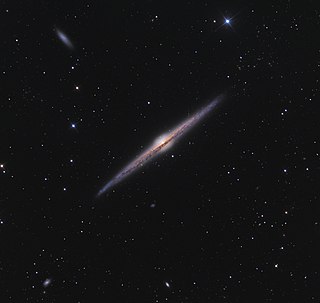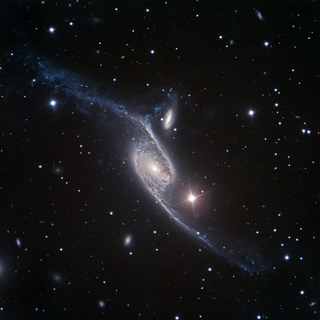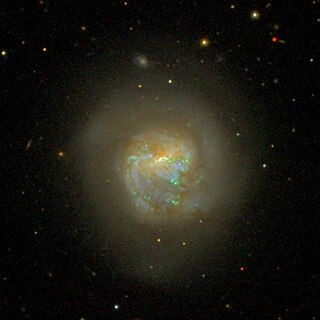
The Pinwheel Galaxy is a face-on spiral galaxy located 21 million light-years from Earth in the constellation Ursa Major. It was discovered by Pierre Méchain in 1781 and was communicated that year to Charles Messier, who verified its position for inclusion in the Messier Catalogue as one of its final entries.

Messier 63 or M63, also known as NGC 5055 or the seldom-used Sunflower Galaxy, is a spiral galaxy in the northern constellation of Canes Venatici with approximately 400 billion stars. M63 was first discovered by the French astronomer Pierre Méchain, then later verified by his colleague Charles Messier on June 14, 1779. The galaxy became listed as object 63 in the Messier Catalogue. In the mid-19th century, Anglo-Irish astronomer Lord Rosse identified spiral structures within the galaxy, making this one of the first galaxies in which such structure was identified.

NGC 4565 is an edge-on spiral galaxy about 30 to 50 million light-years away in the constellation Coma Berenices. It lies close to the North Galactic Pole and has a visual magnitude of approximately 10. It is known as the Needle Galaxy for its narrow profile. First recorded in 1785 by William Herschel, it is a prominent example of an edge-on spiral galaxy.

The Eyes Galaxies are a pair of galaxies about 52 million light-years away in the constellation Virgo. The pair are members of the string of galaxies known as Markarian's Chain.

NGC 6872, also known as the Condor Galaxy, is a large barred spiral galaxy of type SB(s)b pec in the constellation Pavo. It is 212 million light-years (65 Mpc) from Earth. NGC 6872 is interacting with the lenticular galaxy IC 4970, which is less than one twelfth as large. The galaxy has two elongated arms with a diameter based on ultraviolet light of over 522,000 light-years (160,000 pc), and a D25.5 isophotal diameter of over 717,000 light-years (220,000 pc), making it the largest known spiral galaxy. It was discovered on 27 June 1835 by English astronomer John Herschel.

NGC 5033 is an inclined spiral galaxy located in the constellation Canes Venatici. Distance estimates vary from between 38 and 60 million light years from the Milky Way. The galaxy has a very bright nucleus and a relatively faint disk. Significant warping is visible in the southern half of the disk. The galaxy's relatively large angular size and relatively high surface brightness make it an object that can be viewed and imaged by amateur astronomers. The galaxy's location relatively near Earth and its active galactic nucleus make it a commonly studied object for professional astronomers.

NGC 5713 is a peculiar, asymmetric galaxy in the constellation Virgo. Although classified as a spiral galaxy by most galaxy catalogs, NGC 5713 is very different from most normal spiral galaxies. While most spiral galaxies either have either two well-defined spiral arms or a filamentary spiral-like structure, this spiral galaxy has only one visible spiral arm in its disk. This makes it a galaxy of the Magellanic type. Gravitational interactions with the nearby spiral galaxy NGC 5719 may be responsible for producing the disturbed, asymmetric structure including the single spiral arm.

NGC 5005, also known as Caldwell 29, is an inclined spiral galaxy in the constellation Canes Venatici. The galaxy has a relatively bright nucleus and a bright disk that contains multiple dust lanes. The galaxy's high surface brightness makes it an object that is visible to amateur astronomers using large amateur telescopes.

NGC 4618 is a distorted barred dwarf galaxy in the constellation Canes Venatici. The galaxy is formally classified as a Sm galaxy, which means that its structure vaguely resembles the structure of spiral galaxies. The galaxy is sometimes referred to as a Magellanic spiral because of its resemblance to the Magellanic clouds.

NGC 4449, also known as Caldwell 21, is an irregular Magellanic type galaxy in the constellation Canes Venatici, being located about 13 million light-years away. It is part of the M94 Group or Canes Venatici I Group that is relatively close to the Local Group hosting our Milky Way galaxy.
The H I Parkes All Sky Survey (HIPASS) is a large survey for neutral atomic hydrogen (H I). Most of the data was taken between 1997 and 2002 using CSIRO's 64 m Parkes Telescope. HIPASS covered 71% of the sky and identified more than 5000 galaxies; the major galaxy catalogs are: the "HIPASS Bright Galaxy Catalog", the southern HIPASS catalog (HICAT), and the northern HIPASS catalog (NHICAT) Discoveries include over 5000 galaxies, the Leading Arm of the Magellanic Stream and a few gas clouds devoid of stars.

NGC 925 is a barred spiral galaxy located about 30 million light-years away in the constellation Triangulum. The morphological classification of this galaxy is SB(s)d, indicating that it has a bar structure and loosely wound spiral arms with no ring. The spiral arm to the south is stronger than the northern arm, with the latter appearing flocculent and less coherent. The bar is offset from the center of the galaxy and is the site of star formation all along its length. Both of these morphological traits—a dominant spiral arm and the offset bar—are typically characteristics of a Magellanic spiral galaxy. The galaxy is inclined at an angle of 55° to the line of sight along a position angle of 102°.
A Magellanic spiral galaxy is a spiral galaxy with only one spiral arm. Magellanic spiral galaxies are classified as the type Sm ; the prototype galaxy and namesake for Magellanic spirals is the Large Magellanic Cloud, an SBm galaxy. They are usually smaller dwarf galaxies and can be considered to be intermediate between dwarf spiral galaxies and irregular galaxies.

NGC 3860 is a spiral galaxy located about 340 million light-years away in the constellation Leo. NGC 3860 was discovered by astronomer William Herschel on April 27, 1785. The galaxy is a member of the Leo Cluster and is a low-luminosity AGN (LLAGN). Gavazzi et al. however classified NGC 3860 as a strong AGN which may have been triggered by a supermassive black hole in the center of the galaxy.

NGC 7469 is an intermediate spiral galaxy in the constellation of Pegasus. NGC 7469 is located about 200 million light-years away from Earth, which means, given its apparent dimensions, that NGC 7469 is approximately 90,000 light-years across. It was discovered by William Herschel on November 12, 1784.

NGC 3367 is a barred spiral galaxy located in the constellation Leo. It is located at a distance of about 120 million light years from Earth, which, given its apparent dimensions, means that NGC 3367 is about 85,000 light years across. It was discovered by William Herschel on March 19, 1784.

NGC 7130 is a spiral galaxy located in the constellation Piscis Austrinus. It is located at a distance of about 220 million light years from Earth, which, given its apparent dimensions, means that NGC 7130 is about 100,000 light years across. It was discovered by John Herschel on September 25, 1834, and discovered independently by Lewis Swift on September 17, 1897. The location of the galaxy given in the New General Catalogue was off by 30 arcminutes in declination from the location of the galaxy.

NGC 4294 is a barred spiral galaxy with flocculent spiral arms located about 55 million light-years away in the constellation Virgo. The galaxy was discovered by astronomer William Herschel on March 15, 1784 and is a member of the Virgo Cluster.

NGC 4299 is a featureless spiral galaxy located about 55 million light-years away in the constellation Virgo. It was discovered by astronomer William Herschel on March 15, 1784 and is a member of the Virgo Cluster.

NGC 4302 is an edge-on spiral galaxy located about 55 million light-years away in the constellation Coma Berenices. It was discovered by astronomer William Herschel on April 8, 1784 and is a member of the Virgo Cluster.



















